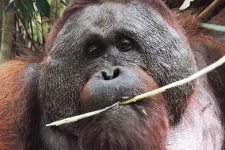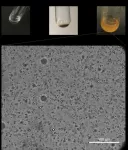(Press-News.org) It's a tough time to be a shark. Pollution, industrialized fishing, and climate change threaten marine life, and the populations of many top ocean predators have declined in recent years. In addition to studying sharks in the wild, scientists working to save sharks rely on ones living in zoos and aquariums so that they can help build breeding programs and learn more about the conditions sharks need to thrive. One important way the scientists do that is by playing matchmakers to the sharks, pairing up individuals in ways that increase genetic diversity. In a new study in Scientific Reports, scientists undertook the largest-ever effort to artificially inseminate sharks.Their work resulted in 97 new baby sharks, including ones whose parents live on opposite sides of the country and a few that don't have fathers at all.
"Our goal was to develop artificial insemination as a tool that could be used to help support and maintain healthy reproducing populations of sharks in aquariums," says Jen Wyffels, the paper's lead author who conducted the research for this paper with the South-East Zoo Alliance for Reproduction & Conservation and is currently a researcher at the University of Delaware.
"Moving whole animals from one aquarium to another to mate is expensive and can be stressful for the animal, but now we can just just move genes around through sperm," says Kevin Feldheim, a researcher at Chicago's Field Museum and a co-author of the study who led the DNA analysis of the newborn sharks to determine their parentage.
Figuring out shark parentage can be tricky because shark reproduction isn't always straightforward. In some species, female sharks can store sperm for months after mating and they use it for fertilization "on demand", so the father of a newborn shark isn't necessarily the male the mother most recently had contact with. Some female sharks are even capable of reproducing with no male at all, a process called parthenogenesis. In parthenogenesis, the female's egg cells are able to combine with each other, creating an embryo that only contains genetic material from the mother.
To study shark reproduction, the researchers focused on whitespotted bamboo sharks. "When people think of sharks, they picture great whites, tiger sharks, and bull sharks--the big, scary, charismatic ones," says Feldheim. "Whitespotted bamboo sharks are tiny, about three feet long. If you go to an aquarium, they're generally just resting on the bottom." But while bamboo sharks' gentleness and small size make them unlikely candidates for Hollywood fame, those qualities make them ideal for researchers to try to artificially inseminate.
Before attempting artificial insemination, researchers have to make sure that the potential mothers aren't already carrying sperm from a previous rendezvous. "Candidate females are isolated from males and the eggs they lay afterwards are monitored to make sure they are infertile," says Wyffels. Egg-laying sharks regularly lay eggs on a regular schedule, much like chickens, says Wyffels, to the point that they're nicknamed "chickens of the sea." To determine if the eggs are infertile, scientists shine an underwater light through the leathery, rectangular egg cases (called "mermaid's purses") to see if there's a wriggling embryo on top of the yolk. If there are no fertilized eggs for six weeks or more, the shark is ready to be inseminated.
Scientists collected and evaluated 82 semen samples from 19 sharks in order to tell the difference between good and bad samples. Some of the good samples went to nearby females for insemination, while others were kept cold and shipped around and across the country. Once the semen reached Ripley's Aquarium of the Smokies or Aquarium of the Pacific, where a female was waiting, researchers sedated her and placed the semen in her reproductive tract--the procedure took less than ten minutes. All in all, 20 females were inseminated as part of the study.
Baby sharks hatched from fertilized eggs after 4 months of incubation. "The hatchlings are about the size of your hand, and they have distinctive spot patterns that help to tell them apart," says Wyffels. Tissue samples were taken from all the babies, along with their parents, so Feldheim could analyze their DNA at the Field Museum's Pritzker Laboratory for Molecular Systematics and Evolution.
Feldheim developed a suite of genetic markers to determine parentage. "We sequenced the DNA and found sections where the code repeats itself," says Feldheim. "These repeating bits of code serve as signatures, and when we see them in the babies, we match them up to the potential dads." The team found that freshly collected semen was effective in fertilizing eggs in 27.6% of cases; semen that had been cold-stored for 24 or 48 hours had 28.1% and 7.1% success rates, respectively. In the genetic analysis of the offspring, the team also found two instances of parthenogenesis, where the mother reproduced on her own without using the sperm she'd been inseminated with. "These cases of parthenogenesis were unexpected and help illustrate how little we know about the basic mechanisms of sexual reproduction and embryo development among sharks," says Wyffels.
From these preliminary results, the scientists hope to help aquariums expand and manage their shark breeding programs. "There have been other reports on artificial insemination of sharks, but they include very few females. In this study, we're in the double digits and as a result we could investigate different methods for preparing and preserving sperm for insemination" says Wyffels. "And a hatchling from shark parents that live almost 3,000 miles apart from sperm collected days in advance, that's definitely a first."
"One of the goals of this pilot project was to just see if it worked," says Feldheim. "Now, we can extend it to other animals that actually need help breeding, from other species in aquariums to sharks under threat in the wild."
The researchers also note that if studies like these contribute to the conservation of sharks in the wild, it will be largely thanks to aquariums. "We wouldn't know about parthenogenesis in sharks if it wasn't for aquariums," says Feldheim.
"Aquariums allow you to observe the same individual animals over time, and that's very difficult to do in the wild," says Wyffels. "Aquarists have eyes on their animals every day. They pick up on subtle changes in behavior related to reproduction, and they tell us what they see. Research like this depends on that collaboration. We are already taking what we learned from this study and applying it to other species, especially the sand tiger shark, a protected species that does not reproduce often in aquariums."
INFORMATION:
This study was led by researchers from the South-East Zoo Alliance for Reproduction & Conservation in collaboration with, the Aquarium of the Pacific, Ripley's Aquarium of the Smokies, The Florida Aquarium, Adventure Aquarium and the Field Museum.
Wild orangutans are known for their ability to survive food shortages, but scientists have made a surprising finding that highlights the need to protect the habitat of these critically endangered primates, which face rapid habitat destruction and threats linked to climate change.
Scientists found that the muscle mass of orangutans on the island of Borneo in Southeast Asia was significantly lower when less fruit was available. That's remarkable because orangutans are thought to be especially good at storing and using fat for energy, according a Rutgers-led study in the journal Scientific Reports.
The findings highlight ...
All modern life is composed of cells, from single-celled bacteria to more complex organisms such as humans, which may contain billions or even trillions of cells, but how life came to be cellular remains uncertain. New research led by specially appointed assistant professor Tony Z. Jia at the Earth-Life Science Institute (ELSI) at Tokyo Institute of Technology, along with colleagues from around the world (Japan, Malaysia, France, Czech Republic, India and the USA), shows that simple chemical compounds known as hydroxy acids, which were likely common on primitive Earth, spontaneously link together ...
Scientists have begun the search for extraterrestrial life in the Solar System in earnest, but such life may be subtly or profoundly different from Earth-life, and methods based on detecting particular molecules as biosignatures may not apply to life with a different evolutionary history. A new study by a joint Japan/US-based team, led by researchers at the Earth-Life Science Institute (ELSI) at the Tokyo Institute of Technology, has developed a machine learning technique which assesses complex organic mixtures using mass spectrometry to reliably classify them as biological or abiological.
In season 1, episode 29 ("Operation: Annihilate!") of Star Trek, which aired in 1966, the human-Vulcan hybrid character ...
PULLMAN, Wash. - Rush hour will likely return when pandemic lockdowns lift, but a new study suggests that congestion pricing--policies that charge tolls for driving during peak hours--could not only cure traffic jams but also convince motorists it is safe to buy smaller, more efficient cars.
Researchers from Washington State University and the Brookings Institution studied a sample of nearly 300 households in the Seattle area over a six-year period, finding that the more congested their commutes, the more likely they would buy bigger cars which they perceive as safer and more ...
New research presented at this year's European Congress on Obesity (held online, 10-13 May) shows that the obesity drug semaglutide reduces appetite, food cravings and energy intake in people given a meal where they could eat as much as they liked. The study is by Dr Dorthe Skovgaard, Novo Nordisk A/S (the manufacturer of the drug), Søborg, Denmark, and colleagues.
Semaglutide, in the glucagon-like peptide-1 (GLP-1) analogue drug class, is currently available at the dose of 1.0 mg injected once weekly for the treatment of type 2 diabetes and is under development for chronic weight management at the dose ...
An early study of a new experimental drug to treat obesity known as cagrilintide shows that, when combined with semaglutide 2.4 mg, the combination leads to more weight loss than semaglutide 2.4 mg alone and is well tolerated. This phase 1 study, which was recently published in The Lancet will be presented at this year's European Congress on Obesity (held online, 10-13 May) by Dr Lone Enebo, Novo Nordisk A/S, Denmark, on behalf of her colleagues. Novo Nordisk A/S is the manufacturer of both drugs in this study.
Combining medications with different modes of action may provide more effective treatment options for people with obesity. Weekly injections of cagrilintide, ...
Two-thirds of California prisoners who were offered a COVID-19 vaccine accepted at least one dose, according to a new study by researchers at the Stanford University School of Medicine.
"We found that many incarcerated people in California prisons were willing to be vaccinated for COVID-19," said Elizabeth Chin, the lead author of the study and a PhD candidate in biomedical data science. "This is an encouraging sign for other states at an early stage of rolling out vaccination programs in their prisons and jails."
The researchers also found that nearly half of those who initially turned down a COVID-19 vaccine accepted it when it was offered to them again. The finding is an important indication that vaccine hesitancy is not necessarily fixed.
Two-thirds ...
The 1949 letter by the physicist and Nobel laureate discusses bees, birds and whether new physics principles could come from studying animal senses.
It's a position still being realised within physics to this day, with a growing body of research and understanding of how animals such as birds and bees find their way around.
Now a study led by RMIT University in Melbourne, Australia, discusses how recent discoveries in migratory birds back up Einstein's thinking 72 years ago.
The previously unpublished letter was shared with researchers by Judith Davys - Einstein had addressed ...
If you did not catch the flu this year -- and there is an overwhelming chance that you did not -- you have COVID-19 to thank.
It's a small consolation, given the enormously disruptive scope of the pandemic. But it's the focus of a new paper published in the journal Frontiers in Public Health by two Concordia researchers and their colleagues that studies the 2020 influenza figures from Canada, the United States, Australia and Brazil. The authors show there is a clear relationship between the implementation of COVID-mitigation measures such as hand-washing, masking and social distancing and the spread of the annual flu.
They write that these preventive measures all but eliminated ...
The quest to create safer, more successful pregnancies is one of the top goals of modern science. While pregnancy is better understood today than ever before, with improvements in technology helping to lower the risk of negative outcomes, there is much researchers still don't know about a vital part of the pregnancy process: uterine fluid.
Secreted by glands in the uterus during pregnancy, uterine fluid is believed to play an important role in supporting a developing embryo by sending information from the uterus to the embryo, along with a host ...






